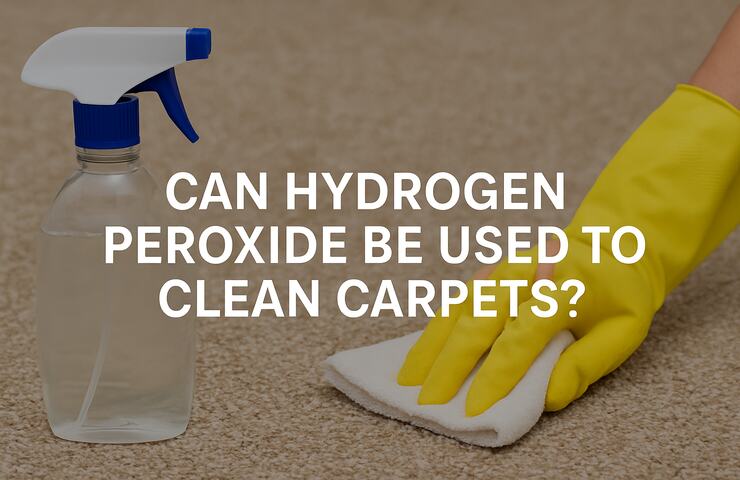Can Hydrogen Peroxide Be Used to Clean Carpets?
Has the question, “Is there anything at home that can fix this?” ever crossed your mind? Following a spill on your carpet of wine, coffee, or worse? You’re not by yourself. Carpet stains are usually a real bother, chiefly when they drop their presence on-demand before a guest arrives or after a long, tiring day when one least expects them. Among the many different remedies that one would find suggested online, hydrogen peroxide is usually touted as a miracle cleaner. But does this mean it is safe to use on a carpet? Or will it turn out to harm it?
Let’s dive deepest into the science, benefits, the risks, and whether hydrogen peroxide deserves a tropical vacation in your cleaning kit. That comes as a spoiler: the reality is very complex, more than a simple yes-or-no answer. That will be your call by the end of this article.
What Is Hydrogen Peroxide?
Hydrogen peroxide is an odourless, clear liquid used in disinfecting household surfaces, as per Bond Cleaners Sunshine Coast. Its chemical structure is the same as water, but it is reactive due to the presence of an extra oxygen atom.
This unusual property of being reactive lets it disintegrate organic substances such as blood, moulds, and food stains. Most pharmacies sell hydrogen peroxide in a standard 3% strength; indeed, it is safe for many everyday uses, such as cleaning, bleaching, and first aid. This, however, does not make it a guarantee that it is safe for all types of carpets, more especially when colour sensitivity or material sensitivity are in question.
Is It Effective on Carpets?
Hydrogen peroxide can clean carpets but it requires caution. Its strengths lie in removing stains from natural spills and messes like blood, wine, coffee, and pet accidents. The bubbling action produced by hydrogen peroxide on stains means they are actually breaking down molecules in the fabric so the stains can come out more easily. It may also be antibacterial, actually sanitizing some areas exposed to germs or waste.
When to Use Hydrogen Peroxide for Carpet Cleaning
Hydrogen peroxide may be used more successfully with light-colored carpets as the risk of discolouration is slight. This treatment is best for newly made stains rather than ones that have already set into the fibres over time. Occult power comes when small amounts of hydrogen peroxide are added to a myriad of combinations with gentle cleansers such as baking soda or dish soap. An apt comparison would be to compare hydrogen peroxide with baking soda because this combination works well against stuck stains and odour removals, happy to be there for your pet accidents.
How to Use It: A Stepwise Tutorial
Ensure to do a spot test before applying hydrogen peroxide on the carpet. Put some in a corner away from view and wait for hours to see if it fades or damages. If there appears to be no change, then proceed with the application.
First, blot the spill area with a dry cloth as it absorbs the liquid. Never rub it, for it might get deeper into the carpet fibres. After that, apply a few drops of 3% hydrogen peroxide to the affected discolouration and let it sit for five to ten minutes. There may be some fizzing and bubbles as a result of the oxygen produced when the peroxide attacks the stain.
Once enough time has passed, blot with a fresh cloth again, absorbing the stain as much as possible. When most of the stain has been absorbed, use a clean cloth, moistened with water, to rub away any leftover peroxide that may attract dirt. Dry the spot with a towel, and again, if necessary, use a fan to speed up drying.
Risks and Precautions to Consider
Being one of the best stain removers also means that hydrogen peroxide might have its own risks attached. The most common one is bleaching. Carpets of a darker color or those with mildly visible patterns may get lightened unevenly by hydrogen peroxide, which is almost impossible to cover up. Therefore, tread with care should your carpet fall under any color tones but light beige or white.
Prolonged or repeated use of hydrogen peroxide causes certain carpet fibers to lose their strength. This is more so with natural fibres like wool.
Safer Alternatives to Try
If you are concerned about hydrogen peroxide’s bleaching effect on stains, then several gentler types of cleaning methods can be tried. For light stains and deodorising, a diluted solution of white vinegar and water is best. Club soda, neat and unexpected, is also a fairly decent choice for new stains, especially stains of wine or juice.
Enzyme cleaners are great for general pet situations. Such products are designed to decompose organic matter on a molecular level without causing damage to a carpet. Baking soda underwater paste is a gentle way for spot cleaning and deodorising, too.
When It’s Time for the Pros
Certain stains will not respond well to any DIY procedure, including a homemade hydrogen peroxide solution. Once large stains or stubborn odours have been involved even if the rugs are antique or expensive when discolouration has been repeatedly attempted in vain, it is time to get the experts involved. Professional carpet cleaners use commercial-level methods and solutions that are safe yet highly effective for the finest materials and the most stubborn of stains.
Final Verdict: Yes, But Use It Wisely
Hydrogen peroxide for carpet cleaning is surely one, but can be used with great care. It gives very fine results on light carpeting and fresh organic stains. Improper use of the same oversight is bound to bring damage or discolouration, or further dirt issues.
Always test, use sparingly, rinse well, and when in doubt, consult an expert. When used in a wise manner, hydrogen peroxide can reliably serve as one of the resources for home cleanup.



